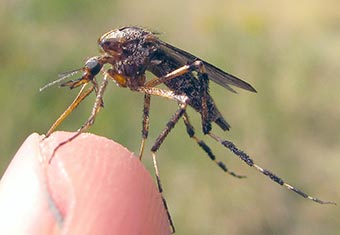Spotlight
Big Problem
| USF News

Photo by Katy Hennig | USF News
According to USF St. Petersburg biologist Deby Cassill, it’s just a matter of time before the flying, “hairy legged-zebra” invades Florida.
“We have this huge potential with all of these eggs that were laid during Tropical Storm Debbie. The next storm coming in that wets that surface, we’re going to have a huge population explosion of this giant mosquito,” she says.
American Giant Mosquitoes, or Psorophora ciliata, lay their eggs in low-lying areas with damp soil and grassy overgrowth. When the areas flood following a dry period, large numbers of adult mosquitoes hatch.
The mosquitoes, also known as galinippers, are notorious for inflicting a painful bite. And they bite both day and night, in stark contrast to the typical dusk and dawn flights of smaller species of mosquitoes.
According to Cassill, the insect originates near the area of the Mississippi River delta. With heavy rains during previous tropical storms, it migrated to Florida.
“They’ve been called the hairy-legged zebra of the mosquito world. And I think that they are not as big as a quarter. But their legs are long enough and their bodies are long enough to span a dime and in the mosquito world, that’s a big animal — kind of like a dinosaur or a large vampire floating around and going after us.”

Psorophora ciliata — the American Giant Mosquito or galinipper.
Photo by Jim Brighton
The bite from the giant mosquitoes feels more intense than that of the smaller types because the giants have saw-like mouthparts that inject saliva and create intense pain when extracting the jaw after the bite.
Cassill says the critters do not carry disease, but they consume the larvae of other types of disease-carrying mosquitoes. And they don’t move around that fast.
“What they go after actually is they have carbon dioxide or CO2 detectors and when they smell the breath of humans or the breath of cattle or the breath of livestock, that is one of the long distance detectors. When they are close enough, they use their vision. Then after that they have little heat detectors and they’ll go for the warm spots along the throat, behind the knees, sometimes behind the neck and zero in and poke that long jaw into our bodies.”
Cassill says the best protection from the American Giant Mosquito is an old technology.
“Just be aware of it; have your fly swatter or mosquito swatter.”